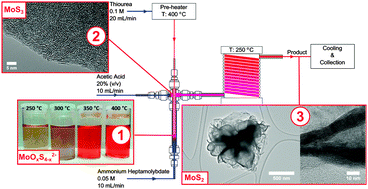The sequential continuous-flow hydrothermal synthesis of molybdenum disulphide
Abstract
Molybdenum disulphide (MoS2) has been widely used as a catalyst and high temperature lubricant. It has been heavily researched recently as a graphene analogue and member of the so-called inorganic fullerenes. Here we report the first continuous flow hydrothermal synthesis of MoS2. With fast reaction times and flexibility the continuous flow hydrothermal system allowed MoS2 to be produced in a stepwise fashion, offering an insight into the mechanism involved. It has been found that the synthesis of MoS2 proceeded via the sulphidation of molybdate anions to thiomolybdate species, which are transformed to amorphous MoS3 by acidification in flow, before further hydrothermal treatment decomposes this amorphous precursor to tangled MoS2 nanosheets.


 Please wait while we load your content...
Please wait while we load your content...